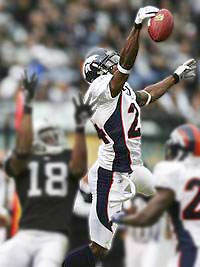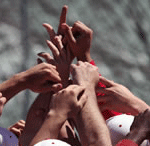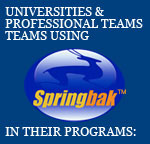Author Archive
Effective Volleyball Shot Blocking Tips from Springbak
Posted by: | Comments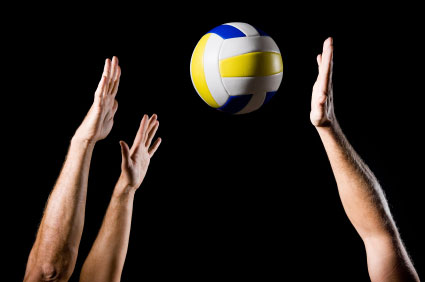 Among all the frustrating volleyball scenarios, perhaps none is worse than having a hitter get the ball by you again
and again
and again. It can get so bad that you feel that what you’re doing isn’t blocking but simply getting extra jumping practice.
Among all the frustrating volleyball scenarios, perhaps none is worse than having a hitter get the ball by you again
and again
and again. It can get so bad that you feel that what you’re doing isn’t blocking but simply getting extra jumping practice.
If that sounds familiar, believe it or not, there is hope. While it’s true that blocking is somewhat helped by height, arm length and vertical leap, technique and smarts also play a big role.
Here are a few tips on how to block almost any hitter in almost any situation:
One key to successful blocking is to build a solid barrier that extends over the net – even if it just means getting your hands across the net. As you reach over, there should be as little space as possible between your arms and the top of the net. If you can create a tight ‘seal’ with the net without touching it, you’ll make it impossible (or almost) for the hitter to bang a ball off your hands and force it to dribble down your body on your side of the net. To create a seal, remember to achieve full extension of your arms (elbows locked, shoulders shrugged, head down with eyes up) and reach over the net as fast as you can. Even if you only get your wrists and hands over the net, its better to create a seal than to make your hands a flat up-and-down wall.
Think ‘shield’, not ‘weapon’. While technically a block is a defensive weapon, it helps to think of the blocking action as a shield or a force field against a hitter, not an offensive maneuver. Many people try to attack the ball when they block, slapping at their opponent’s hit as it crosses the net. This can produce an undesirable result: it unseals the top of the net; it’s a low-percentage opportunity because you have to time your slap exactly right to reject your opponent’s hit; you can’t guide the ball where you want it upon contact; and it’s very difficult for your teammates to line up for defense behind you. So, instead, think of yourself as an impenetrable wall or force field. You’re an immovable object set in place to repel the force of the ball. Extend far over the net, hold that block as long as possible, and try to line yourself up so the ball rebounds off your ‘wall’.
Different players have different preferences about how wide they’ll spread their arms during a block. This also varies from a single block to a double block. In a double, the width is generally less than with a single block. Assuming you’re solo blocking, keep your hands about a ball-width apart, with your fingers spread and rigid to create the most surface area. Your thumbs should not touch. If they do, your hands are TOO close together. A comfortable distance might be four to six inches between your thumbs if you have small hands, and a little wider if you have big hands. If your hands are too close together, you’re not taking away enough space from your opponent. If your hands are too far apart, you’re inviting your opponent to score a field goal by blasting the ball through the opening. Ouch! This is a matter of adjustment, and it’s often helpful to ask your coach or teammates for feedback on your positioning. Always get feedback from your coach, he/she wants you to ask!
Many blockers make the mistake of watching only the hitter, but the set can tell you much more about what kind of attack is coming. Is the ball far off the net? That means the hitter probably can’t hit straight down and will have a slightly slower/delayed approach, since he’ll most likely have to adjust his footwork. This means you need to begin your block jump a bit later and reach high. Is the set close to the net? By all means, make sure you get maximum penetration. A low set? Get ready to jump sooner. Naturally, the hitter can also give you information. Watch the angle of his approach. This can tell you where to line up as he begins his hitting motions.
Watch his shoulder and upper body. Is there a lot of rotation? He may be preparing to hit across his body.
Does his shoulder or elbow drop? A shot might be coming. Learning to read these clues can make your blocking decision a whole lot easier.
Final thoughts. Sometimes, no matter what you do, there will be a hitter who seems unblockable. If you’re facing a 6-9 hitter and you’re 5-8, it’s possible that despite your best intentions, form, and attention to detail, he’ll still hit over you. But the tips above should help you match up better for most game situations.
Dave Richard, Head Coach Utah Valley University Men’s Volleyball – “This 2009 season, I personally tested the vertical leap of my six starters. They averaged 32 inches and 38 inches in their vertical leap. They averaged 3 inches higher after inserting Springbak® Springsoles in their shoes, increasing their average vertical leaps to between 35 inches and 41 inches.”
Enjoy the volleyball tips and best of luck this season to all our sponsored Universities and Club Teams.
Mark Vona – GM Springbak, Inc.
Visit the Official Springbak® Website at www.springbak.net – Peak Performance Springsoles / Insoles – Run Faster, Jump Higher, Lessen Fatigue
LIKE us on Facebook: www.facebook.com/springbak
Tweet with us on Twitter: www.twitter.com/springbak
Friend us on MySpace: www.myspace.com/springbak
Tune in on YouTube: www.youtube.com/springbakinc
Springbak Sponsors Nebraska Huskers Women’s Volleyball for 2014-15 Seasons
Posted by: | CommentsSpringbak announces the official sponsorship of Nebraska Huskers volleyball with their performance volleyball insoles.
 The philosophy of coach John Cook at Nebraska can be summarized in two simple words.
The philosophy of coach John Cook at Nebraska can be summarized in two simple words.
Dream Big.
When Cook took over the reins of the Nebraska volleyball program, the challenge facing him was daunting. Cook replaced one of the sport’s legendary coaches in Terry Pettit, who won 694 matches and guided the Huskers to 18 consecutive NCAA appearances and six national semifinals.
Cook, who left an emerging power in Wisconsin to guide the tradition-rich Husker program, had his own vision for Nebraska volleyball. He saw a program that had even more potential to grow. His goals included consistently selling out home matches at the NU Coliseum, expanding the media exposure for his program and most importantly, continuing the tradition of athletic and academic excellence started by Pettit nearly a quarter of a century earlier.
Cook saw the long-range potential of building the audience across the state. He also believed Nebraska could shine by hosting the sport’s championship in the largest setting college volleyball had ever seen.
When others saw risks, Cook saw opportunities.
The Huskers entered the 2006 campaign with many questions, as they were forced to replace three All-Americans, including AVCA National Player-of-the-Year Christina Houghtelling. With four first-year starters on the court, including freshmen at setter and middle blocker, and sky-high expectations with the NCAA Championships in Omaha for the first time, 2006 shaped up to be Cook’s toughest coaching job to date.
Nebraska took on all challenges head-on, going 33-1 and becoming only the third team in NCAA history to be ranked No. 1 the entire season. The Huskers went on the road and overcame a 2-0 deficit to defeat Minnesota to reach the national semifinals, marking the first time that Nebraska had won a regional outside the state. That victory set the stage for a watershed moment in college volleyball. Behind sellout crowds of over 17,000, the Huskers captured the school’s third national title with victories over No. 4 UCLA and No. 2 Stanford. Four players earned AVCA All-America honors, including Sarah Pavan, who became NU’s first Honda-Broderick Cup winner.
Two years later, the NCAA Championships returned to Omaha with another Husker team taking center stage.
An all-time NCAA attendance record of 17,430 traveled through a winter storm to witness one of the greatest matches in Nebraska’s illustrious history. After dropping the first two sets to No. 1 Penn State, Nebraska fought back, winning the next two sets to hand the Nittany Lions their only set losses of the 2008 season. Although the Huskers were unable to complete the comeback, the performance symbolized a never-say-quit attitude that fueled the team’s success. Despite losing a pair of performers to season-ending injuries, the Huskers went 31-3 and won their fifth consecutive conference title. At the Seattle Regional, the Huskers overcame a 2-0 deficit to send the match to a fifth set and trailed 9-3 in the fifth set before regrouping and earning the school’s 11th trip to the NCAA semifinals. Jordan Larson, Tara Mueller and Sydney Anderson all earned All-America honors, while Larson was named Big 12 Player of the Year and Defensive Player of the Year, becoming the first player in conference history to sweep both honors.
Consistent excellence has been a hallmark of Cook’s Nebraska squads. Over the last decade, Cook has guided the Huskers to a pair of national titles, five NCAA semifinal appearances and nine Big 12 titles. His teams have compiled a national-best 336-29 record, including a 207-13 Big 12 mark. Overall, Cook is 106-24 against ranked teams at NU, including a 20-11 mark against top-five teams.
In 2010 the Huskers won their 31st overall conference title and their 12th as a member of the Big 12 Conference with an overall record of 29-3. The team also made its 29th straight trip to the NCAA Tournament and improved its all-time record in tournament record to 82-26. The Huskers’ all-time AVCA All-America total reached 70 with Brooke Delano being named a first-team honoree, while Lindsey Licht and Hannah Werth were second-team picks. Werth was also tabbed as the Big 12 Defensive Player of the Year and Cook was named Co-Big 12 Coach of the Year.
Cook’s vision is for the Huskers to remain at the forefront of college volleyball to enhance the sport at both the local and national levels. Nebraska will enter 2011 with an NCAA-record 149 consecutive sellouts at the NU Coliseum – the longest sellout streak in NCAA women’s athletics.
“It is a reflection of Nebraska volleyball and the program, and not about one person or one player,” Cook said when accepting the AVCA Coach-of-the-Year Award in 2005. “We’re trying to be a leader in the sport. We’re trying to take risks and dream big, and fortunately I’m surrounded by a lot of people who have that vision. I’m really proud of what we’re doing to try and enhance the sport.”
Three Straight 30-Win Seasons Cook immediately started to create his own legacy after taking over for Pettit. In his first season at the helm, Cook was named the AVCA National Coach of the Year after guiding the Huskers to a 34-0 record and the 2000 national championship. The Huskers, who became just the second team in NCAA history to cap an undefeated season with a national title, were ranked No. 1 in the AVCA/USA Today Top 25 poll for 14 straight weeks. Greichaly Cepero earned AVCA National Player-of-the-Year honors. Three Huskers claimed AVCA All-America certificates, and five Nebraska players were named to the All-Big 12 teams. Laura Pilakowski earned CoSIDA Academic All-America honors, and a conference-best seven Huskers earned academic All-Big 12 recognition.
In 2001, Cook’s second season, Nebraska fell just two wins short of capturing another NCAA title. The Huskers, who were ranked either No. 1 or No. 2 in the AVCA poll all season, went 20-0 in the Big 12 and Cook was named the Big 12 Coach of the Year. NU finished the season with a 31-2 record after falling to eventual national champion Stanford in the NCAA semifinals. Nebraska placed four players on the AVCA All-America teams, while right side hitter Nancy Metcalf was selected as an NCAA Top Eight Award winner and was also named the CoSIDA Academic All-American of the Year. Pilakowski and Cepero joined Metcalf on the CoSIDA Academic All-America teams, as Pilakowski earned second-team honors and Cepero received third-team recognition.
In Cook’s third season, the Huskers continued their remarkable success. NU finished the season ranked fifth in the AVCA poll with a 31-2 record to secure its third straight 30-win season. Nebraska produced the most dominant conference season in school history, going 20-0 and losing just two sets en route to winning the league championship for the third straight year. Cepero and Amber Holmquist again earned first-team AVCA All-America honors, and Pilakowski was recognized on the second team. Pilakowski was named a first-team CoSIDA Academic All-American, and Holmquist was a second-team pick. Cepero, Holmquist and Pilakowski shared Big 12 Player-of-the-Year accolades.
Cook faced perhaps his greatest coaching challenge at Nebraska in 2003, when the Huskers had to replace three All-Americans and their first-ever libero. That season, Cook opted to run a 6-2 (two-setter) offense to utilize as many players as possible. NU went on to finish the season with a 28-5 record and an appearance in the Sweet 16.
The 2004 season may have been one of Cook’s best coaching jobs, as a youthful squad that featured five freshmen and sophomores in the lineup went 30-2 and was ranked No. 1 heading into the NCAA Tournament. The Huskers led the nation in both opponent hitting percentage (.103) and blocks per game (4.02) before falling to two-time defending NCAA champion USC in five sets in the regional final. Three Huskers earned AVCA All-America honors, while Pavan was chosen as the AVCA National Freshman of the Year. That group of Huskers became the centerpiece of Nebraska’s consecutive NCAA Finals teams in 2005 and 2006.
Building the Badgers Cook, who served as an assistant under Pettit for three seasons from 1988 to 1991, took over the Nebraska head coaching job after serving as associate head coach during the 1999 season. Before returning to Nebraska in 1999, Cook led Wisconsin to six straight postseason appearances in seven seasons as the Badgers’ head coach.
Cook’s accomplishments at Wisconsin earned him praise as one of the game’s top young coaches. Cook built the Badgers into a top-10 program during his seven-year career in Madison, which included back-to-back trips to the NCAA regional finals in 1997 and 1998. In his final match at Wisconsin, Cook’s Badgers fell to the Huskers in a three-hour, five-set battle in the 1998 Pacific Regional Championship in the NU Coliseum. Wisconsin ended the season ranked seventh in the final USA Today/AVCA Coaches Poll with a 30-5 record.
We are proud to sponsor such a great program at Nebraska with our performance volleyball insoles.
William Crow ~ CEO Springbak, Inc.
Visit the Official Springbak® Website at www.springbak.net – Peak Performance Springsoles / Insoles – Run Faster, Jump Higher, Lessen Fatigue
LIKE us on Facebook: www.facebook.com/springbak
Tweet with us on Twitter: www.twitter.com/springbak
Friend us on MySpace: www.myspace.com/springbak
Tune in on YouTube: www.youtube.com/springbakinc
Springbak Running Tips For Sprinters
Posted by: | CommentsHow do genetics affect my running ability?
The past two blog posts we have discussed what type of shoes to purchase to prevent injury and for your foot type, now let’s discuss speed!
 There is a time honored formula for improving running speed: shorten foot-plant time (increase stride frequency) and increase stride length. Let’s discuss a few methods to accomplish both.
There is a time honored formula for improving running speed: shorten foot-plant time (increase stride frequency) and increase stride length. Let’s discuss a few methods to accomplish both.
Speed is perhaps the most coveted component of athletic performance. Whether you are a football player looking to better your 40 yard dash times or a marathoner who wants to improve your distance time, the importance of foot speed in running is unquestionable.
Division I Track and Field programs use our Springbak Springsoles for this very reason. For example, BYU Head Coach, Mark Robison, knows the Springbak Springsoles will accomplish both an increase in stride frequency / stride cadence and an increased stride length for his athletes. All coaches and athletes are seeking a competitive advantage from the equipment they use, to their training programs.
Traditional thinking dictates that to be fast, choose your parents carefully. In other words, speed is a genetic trait. However, while this is true to the extent that it is not possible to be a world class sprinter without genetic endowment, sport science and proper coaching have done much to refute this.
Sprinting speed is an essential element to most sports and a key evaluator of athletic performance. Being geneticly gifted is an important factor that contributes to world-class speed and it cannot be altered period! We need to understand that there are certain individuals that are born with muscular qualities that make them faster simply because of the structural and biochemical properties of their skeletal muscle. However, anyone can increase their speed, just not necessarily to world class athlete status.
The two external factors associated with speed which are trainable are mechanical efficiency (technique) and force production. Mechanical efficiency in sprinting is a skill that must be coached, like swinging a bat, shooting a basketball or throwing a football. When mechanics are perfected, the only way to increase speed is to develop the ability to generate force at greater magnitudes and rates. Sprinting is essentially a game of physics. The athlete who can strike the ground harder and faster, will propel themselves farther down the track, field or court with each step and thus will be faster every time. Talking with world class athletes, Springbak hears the same thing all the time. One of the biggest misconceptions in speed training is that fast sprinters “run light.” In reality, world class sprinters “run violently.” Pound for pound, world-class sprinters are some of the strongest, most powerful athletes in the world and it is that power that separates them from the field.
When watching world class sprinters work out, they shared a lot of training tips, and we are sharing them with you as well. These sprinters use exercises where the foot is in contact with the ground on stable surfaces to develop speed. Because sprinting involves reaction time forces against stable surfaces, sprinting speed is best developed using exercises in which the foot is in contact with the ground and reacts against an immovable surface. Back squats, front squats and deadlifts are exercises that fit into this category. Additionally, the movements in these exercises (extension of the hip, knee, and ankle) are movement specific to the skill of sprinting.
In sprinting, force is generated against the ground on a single leg. Therefore, an ample number of single leg exercises where the foot is in contact with the ground should be incorporated into your program. World class athletes use these methods for a reason – you should too. Lunges, single leg squats and step-ups are all great exercises that can involve triple extension on a single leg and can be used to develop specific sprinting power. Lastly, using plyometrics, or jumping exercises are also great ways to improve sprinting speed. Why? Because plyometrics utilize rapid eccentric and concentric muscle contractions and the forces generated during these exercises are quite similar to sprinting.
Be sure to check the Springbak blog for previous tips and articles!
Article by Mark Vona and Dr. Michael Yessis Phd. – Springbak advisory board.
Visit the Official Springbak® Website at www.springbak.net – Peak Performance Springsoles / Insoles – Run Faster, Jump Higher, Lessen Fatigue
LIKE us on Facebook: www.facebook.com/springbak
Tweet with us on Twitter: www.twitter.com/springbak
Friend us on MySpace: www.myspace.com/springbak
Tune in on YouTube: www.youtube.com/springbakinc
Springbak Running Tips – Proper Running Shoes For Your Foot Type
Posted by: | CommentsJogging gained enormous popularity in the 1970s as a great form of cardiovascular fitness. Since then running has become one of the most popular form of physical fitness in America. Whether you run on an indoor track or outdoors, you can enjoy this activity year-round and fit it comfortably into your daily routine.
 Springbak sponsors many Division I Track and Field programs with high-performance footwear for runners. Our patented Springsoles lengthen your stride length and increase stride frequency, and coaches and trainers endorse our product.
Springbak sponsors many Division I Track and Field programs with high-performance footwear for runners. Our patented Springsoles lengthen your stride length and increase stride frequency, and coaches and trainers endorse our product.
During jogging or running, the 26 bones, 33 joints, 112 ligaments, and a network of tendons, nerves, and blood vessels that make up the foot all work together. That’s why you need to condition your body, build up to a routine, and stretch your muscles, tendons, and ligaments before and after each run. Debilitating muscle strain or more serious injury can result when runners or joggers don’t build up their routines and allow their bodies to strengthen over time.
The most common foot problems associated with jogging or running are: blisters, corns, calluses, Athlete’s Foot, shin splints, Achilles tendonitis, and plantar fasciitis. You can prevent many simple foot problems by using proper foot hygiene. Keep your feet powdered and dry. Wear clean socks every time you run. Make sure your shoes fit properly. Most importantly, let your body be your guide so that you don’t overstrain your legs, ankles, and feet. Always wear Springbak Springsoles in your running or training shoes, these increase athletic performance and give you a competitive edge. At the same time, the Springsoles are a highly effective tool for injury prevention, and great for shin splint problems as well.
Jogging/Running Shoes
Because of the force placed on your legs, ankles, and feet, jogging/running shoes need to provide cushioning for shock absorption. Like walking shoes, you need to select a pair designed for the shape of your foot and your natural foot structure or inclination.
There are three basic foot types:
Pronators are people with relatively flat feet, caused by low arches, which generally leads to over pronation, or a gait in which the ankle rolls inward excessively. People with this foot type need motion control shoes that offer support for mid-foot. Motion-control shoes are more rigid and built on a straight last. These are generally board-lasted shoes, which have a piece of cardboard running the length of the shoe for greater stability. Look for sturdy uppers for added stability and avoid shoes with a lot of cushioning or highly curved toes. Also look for a reinforced heel counter to maintain foot support and stability.
Supinators are people with high arches, which can lead to under pronation that places too much weight on the outsides of the feet. People with this foot type need stability shoes designed for extra shock absorption and often having a curved or semi-curved last. A slip-lasted shoe is also recommended, because the sewn seam runs the length of the shoe giving it greater flexibility. Also look for shoes that are reinforced around the ankle and heel to stabilize the foot and extra cushioning under the ball of the foot.
People with normal feet can wear any type of running shoe, although a curved last is generally preferred. When you run, your foot rolls quickly from the heel to the toe, with your foot bending at the ball on each step. That’s why it is important for running shoes to have enough flexibility in just the right places. However, to help with shock absorption, you need a little more rigidity to support the middle of the foot. Make sure the heel is low, but slightly wider than a walking shoe to help absorb the initial shock when your heel strikes the ground.
Here are some other important tips for buying a good pair of running shoes:
- Shop at the end of the day when your feet are slightly swollen to get a good fit.
- Try on shoes with the socks you will wear when walking. If you use an orthotic, bring that to the store when you try on shoes as well.
- Have your feet measured standing up and fit your shoes to the larger of your two feet.
- Be sure there is enough room in the toe box for your toes to wiggle and about a half inch between your toes and the end of the shoe
- Take time when shopping to try on different brands and walk around the store in each pair. Be sure to walk on a hard surface, not just on carpeting. Let your foot be the guide to the fit, not the shoe size or style.
- Look for lightweight, breathable materials for greater comfort.
- Run your hand all over and inside the shoes to feel for any seams or catches that might irritate your foot.
- Choose shoes that lace for better foot stability and control.
- Make sure your heel fits snugly and does not tend toward slipping out of the shoe.
- Consider buying two pairs and rotating your wear to give each pair time to breath between runs and extend the life of each pair.
- Replace running or jogging shoes twice year or about every 400 miles.
Please feel free to interact and share running tips by entering your comments below. We want to hear for you too!
We hope you have enjoyed our tips – Be sure to check the Springbak blog for previous tips and articles!
– The Team at Springbak, Inc.
Visit the Official Springbak® Website at www.springbak.net – Peak Performance Springsoles / Insoles – Run Faster, Jump Higher, Lessen Fatigue
Find us on Facebook: www.facebook.com/springbak
Follow us on Twitter: www.twitter.com/springbak
Friend us on MySpace: www.myspace.com/springbak
Tune in on YouTube: www.youtube.com/springbakinc
Springbak Spotlight on Hawaii Athletics
Posted by: | Comments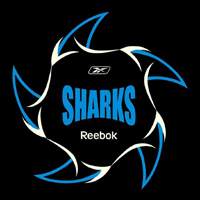 Hawaii loves Springbaks especially those athletes in triathlons, marathons, volleyball and basketball. The Hawaii athletes are more competitive than ever and the Honolulu Sharks Basketball Teams – (www.sharksaau.com) have really put the Springbaks to good use in their gold victories and competitive play in Las Vegas. As more teams compete with our Sharks they learn of the advantages of Springbak Springsoles in their program.
Hawaii loves Springbaks especially those athletes in triathlons, marathons, volleyball and basketball. The Hawaii athletes are more competitive than ever and the Honolulu Sharks Basketball Teams – (www.sharksaau.com) have really put the Springbaks to good use in their gold victories and competitive play in Las Vegas. As more teams compete with our Sharks they learn of the advantages of Springbak Springsoles in their program.
We plan to sponsor the Punahou Basketball Teams this year as their talent deserves to bring back the State Championship with our products.
Currently, sales are good at Runner’s HI, Running Room and at McCully Bike shop, where the latest improved Springbaks can be purchased.
In Japan, several large athletic shoe companies have been evaluating the Springbaks for their shoes in volleyball, soccer and basketball which is very promising. Potential sales and interest are also being developed for Korea and Taiwan as they get more competitive in their sports as well.
In Hawaii, many of the athletes have had great success using the Springbaks with custom orthotics that are digitally fitted for each foot by Shoe Doctor. Orthotics will greatly enhance the athlete’s balance and ability to perform, and when the Springbak’s are added under the orthotics or normal shoe insole, you gain the strength, speed and spring to their specific sport. This is the ultimate customized performance configuration that we are now using with our athletes at the Honolulu Sharks which is strongly recommended. So the point is that when you buy a new shoe for performance, have the person doing the orthotic tell you the proper shoe size that should be ordered so the use of the orthotic and Springbak can be added to the shoe for the right fit, as most people are actually wearing the wrong size shoe for athletics.
For more news, tips and information from Springbak:
Visit the Official Springbak® Website at www.springbak.net – Peak Performance Springsoles / Insoles – Run Faster, Jump Higher, Lessen Fatigue
Find us on Facebook: www.facebook.com/springbak
Follow us on Twitter: www.twitter.com/springbak
Friend us on MySpace: www.myspace.com/springbak
Tune in on YouTube: www.youtube.com/springbakinc

